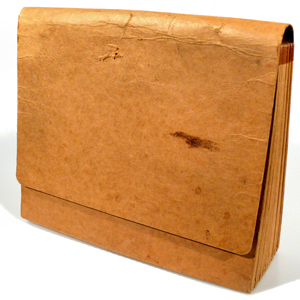 Traditionally, swipe files have been used in advertising and copywriting as a repository for copy, images and layouts. But swipe files can be applied to just about any type of creative work, development projects and writing assignments. They are very easy to create and can save you a great deal of time if you do similar work on an ongoing basis.
What Is a Swipe File?
A swipe file is simply a set of templates or examples that you keep on-hand and refer to when you begin a new project. If you’re a designer, your swipe file may be comprised of great logo designs you’ve come across, creative navigation, unique layouts, fonts and other elements of typography, and stock photos.
A swipe file for a programmer can include code snippets and scripts, while a writer may collect catchy headlines and article outlines.
Why Are They Useful?
Each swipe file is unique. Projects you may find inspiring may not be inspiring to others, so once you create yours, it will be invaluable to you. You can build your swipe file to support your work process, so it’s a one-stop inspiration source.
A swipe file can also be a great way to keep track of your own creative ideas – ideas that you’ve developed and had success with and fragments of ideas you plan to work on at a later time.
How to Create a Swipe File
If you have hard copy examples (i.e. from newspapers or magazines, as Jennifer Farley recently wrote about), you may want to create a physical file with folders for different categories of materials. Or, you can scan them and keep them electronically.
For most of us, the bulk of our swipe files will be electronic. You can collect screenshots, PDFs, URLs, and text files of stimulating examples. You can organize and archive your digital swipe files through a file folder structure, using descriptive file names.
You can also use a notebook application and create a file for inspiration. There are a number of notebook tools that provide an easy way to add data and then search later for specific information. Some tools you may want to check out include:
Traditionally, swipe files have been used in advertising and copywriting as a repository for copy, images and layouts. But swipe files can be applied to just about any type of creative work, development projects and writing assignments. They are very easy to create and can save you a great deal of time if you do similar work on an ongoing basis.
What Is a Swipe File?
A swipe file is simply a set of templates or examples that you keep on-hand and refer to when you begin a new project. If you’re a designer, your swipe file may be comprised of great logo designs you’ve come across, creative navigation, unique layouts, fonts and other elements of typography, and stock photos.
A swipe file for a programmer can include code snippets and scripts, while a writer may collect catchy headlines and article outlines.
Why Are They Useful?
Each swipe file is unique. Projects you may find inspiring may not be inspiring to others, so once you create yours, it will be invaluable to you. You can build your swipe file to support your work process, so it’s a one-stop inspiration source.
A swipe file can also be a great way to keep track of your own creative ideas – ideas that you’ve developed and had success with and fragments of ideas you plan to work on at a later time.
How to Create a Swipe File
If you have hard copy examples (i.e. from newspapers or magazines, as Jennifer Farley recently wrote about), you may want to create a physical file with folders for different categories of materials. Or, you can scan them and keep them electronically.
For most of us, the bulk of our swipe files will be electronic. You can collect screenshots, PDFs, URLs, and text files of stimulating examples. You can organize and archive your digital swipe files through a file folder structure, using descriptive file names.
You can also use a notebook application and create a file for inspiration. There are a number of notebook tools that provide an easy way to add data and then search later for specific information. Some tools you may want to check out include:
- Circus Ponies’ NoteBook – A Mac OS X tool for compiling notes, files, web research, e-mail messages and voice-annotated notes.
- Evernote – A tool for collecting and synchronizing data, including notes, websites, photos, e-mail messages, scanned images and audio, across your desktop, your web account and your mobile devices (a limited free version is available).
- OneNote – Microsoft software that collects notes, images, documents, files from other Microsoft Office programs, and other media in a searchable notebook tool.
- Springnote – A free online wiki-based notebook to compile and share ideas, multimedia, projects, and documents.
- Stixy – A free online free-form design tool to organize notes, pictures, web clippings, and tasks.
- UberNote – A free online tool for collecting notes, tasks and web clippings that allows access from your mobile device.
- Zoho Notebook – An online tool that compiles text, images, audio, video, and allows you to share it with others while providing version tracking.
Frequently Asked Questions (FAQs) about Swipe Files
What is a swipe file and why is it important?
A swipe file is a collection of tested and proven advertising and sales letters. Good copywriters maintain a personal swipe file so they can reference ideas and inspiration for their projects. It’s important because it can save a lot of time and effort in brainstorming and conceptualizing new ideas. It also provides a reference point to understand what works and what doesn’t in the industry.
How can I create an effective swipe file?
Creating an effective swipe file involves collecting successful and impactful sales copies, emails, ad campaigns, and other marketing materials. You can start by subscribing to successful marketers’ email lists, following their blogs, and keeping an eye on their ad campaigns. Save the ones that catch your attention and analyze why they work.
What should I include in my swipe file?
Your swipe file should include any piece of copy that compels you to take action. This could be an email subject line that made you open the email, a headline that caught your attention, or an ad that made you click. It’s also beneficial to include the entire sales letter or advertisement for context.
How often should I update my swipe file?
There’s no hard and fast rule about how often you should update your swipe file. It’s a continuous process and should be updated whenever you come across a piece of copy that you find compelling. The more diverse your swipe file, the more useful it will be.
Can I use the exact copy from my swipe file?
No, the purpose of a swipe file is not to copy but to inspire. It’s about understanding what made a particular piece of copy successful and applying those principles to your own work. Directly copying from your swipe file is not only unethical but could also lead to legal issues.
How can I organize my swipe file?
There are several ways to organize your swipe file. You can categorize by the type of copy (email, sales letter, ad), by industry, or by the emotion they evoke. The key is to create a system that makes it easy for you to find what you need.
Can a swipe file help improve my writing skills?
Absolutely! A swipe file is a great tool for learning and improving your copywriting skills. By analyzing effective copy, you can learn how to write compelling headlines, craft persuasive sales letters, and create engaging ads.
Is a swipe file only useful for copywriters?
While swipe files are particularly beneficial for copywriters, they can also be useful for anyone involved in creating content. This includes social media managers, content marketers, and bloggers. Anyone who needs to persuade their audience can benefit from maintaining a swipe file.
How can I analyze the copies in my swipe file?
Start by looking at the structure of the copy. How is it formatted? What kind of language is used? How does it start and end? Then, try to understand the psychology behind it. What emotions does it evoke? How does it persuade the reader to take action?
Can I share my swipe file with others?
Yes, you can share your swipe file with others. However, remember that your swipe file is a personal tool meant to inspire and educate you. What works for you might not work for someone else. It’s always best to encourage others to create their own swipe file.
Alyssa Gregory is a digital and content marketer, small business consultant, and the founder of the Small Business Bonfire — a social, educational and collaborative community for entrepreneurs.

